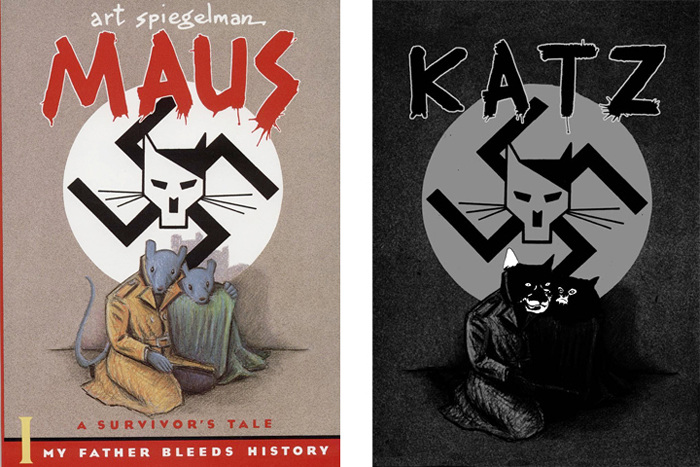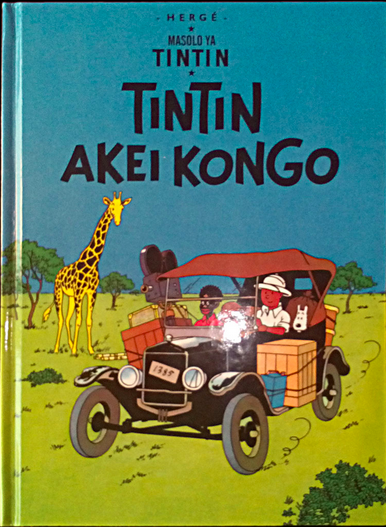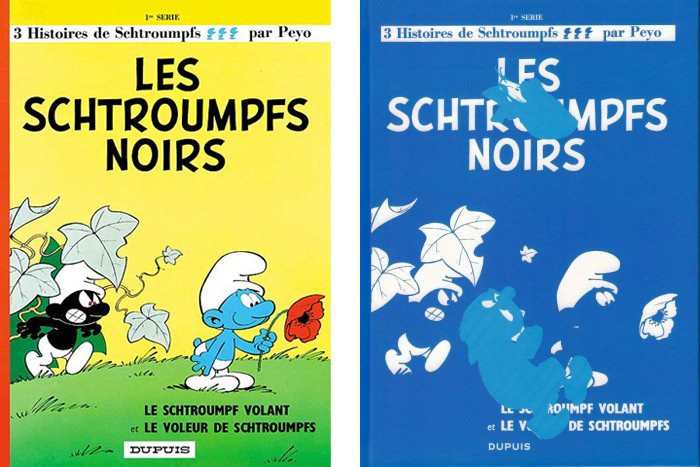 contemporary
contemporary
 ubuweb
ubuweb

Ilan Manouach | Greece

Katz is a pirated edition of Art Spiegelman's seminal graphic novel Maus. Katz is an exact copy of the French edition of Maus, with the difference that all the animal characters, have been redrawn as cats. The book was printed on November 2011 and it was seen in public for the first time in January 2012 during the International Comics Festival of Angoulême that ran under Spiegelman’s presidency. Apparently more than 50 copies were sold simultaneously by several independent publisher bookstands, but the book's ISBN belonged clearly to La Cinquième Couche, a Belgian publishing structure which had already a large catalogue under its belt. The author of this pirated edition was presumably Ilan Manouach. After the Festival, the book was scheduled to be officially distributed by April 2012 and according to Belles Lettres, the distributor, it has already been sold out in pre-order from hundreds of bookshops in France and Belgium. BLDD asks for a reprint but the author and the publisher refuse, underlining the repurposing as a statement.
Two weeks before the book hits officially the book stores, the lawyers of Flammarion, the copyright holder of the French edition of Maus strike back. They send to Mr. Manouach and Mr. Löwenthal, a 500-page document containing spreads from both Maus and Katz, interviews from Ilan Manouach, and his correspondence with Art Spiegelman. Refusing to take on account the conversational nature of the operation and its very limited printrun, Katz is stated as a counterfeit of Maus and Flammarion seeks an injunction against the small Belgian press.
There is also some fuss about the number of copies. The book was printed in Greece and the infringing publisher handled many contradictory proofs of the total print run. The sum fluctuates between 700 and 2000 copies. Flammarion, in the report, states that probably 100 books are hidden in Greece. The same week, in Athens, people break into Manouach’s car and steal 32 books.
La Cinquième Couche and Manouach are positive about the trial. A century of art history, from Duchamp to pop art is enough to prove the validity of this operation. Nevertheless, being already heavily indebted, the publisher, not able to afford the 20.000 starting costs in order to fight the injunction, accepts an out of court settlement: nothing more or less than the total destruction of the books and the digital files. The operation took place in Brussels the 15 march 2012, in a specialised destruction facility.
[original publication: Katz (La Cinquième Couche, 2012)
offset printing, limited print run]

Tintin au Congo (1931) is the second volume of the famous comics series by Belgian cartoonist Hergé. It was commissioned by the conservative Belgian newspaper 'Le Vingtième Siècle' and tells the story of young Belgian reporter Tintin and his dog Snowy, who are sent to the Belgian Congo to report on events in the country. Although it came to be a commercial success and became a defining work of the Franco-Belgian comics tradition, it came under harsh criticism for its perceived racist colonial attitude to the Congolese, portraying them as backwards, lazy and in need of European mastery. Although Hergé might not have been more racist than the average Belgian, his main charge was to persistently align his views with the lowest common denominator without never questioning racial consensus and colonialist politics that were overtly criticized by other contemporary French artists and intellectuals.
Tintin Akei Kongo is the translated version of Tintin au Congo in lingala, the official Congolese dialect. The translation was commissioned by the artist and has been conducted in a collaboration with a certified translator during a prolonged art residency in the island of Ukerewe in Tanzania. This translation belongs in the lineage of similar rip-offs, such as Katz, Noirs or Riki Fermier, books presumably made by Ilan Manouach. The artist, well aware of the material properties of the original edition, replete with its own signifying potential, made explicit his faith in the societal forms of this commodity: the new book is an exact fac-simile of the original edition and follows the industrial standards and layout of classical comics. The goal of this endeavour was not simply to construe the artist's tasks through a redefinition of the possible interventions, by commissioning a translation himself; neither to emphasize the importance of discursivity and self-referentiality as a way to address comics both as a language and a form of logic.
The goal is neither to fill a historical error by making accessible this work in the language of the mainly interested, the oppressed, the insulted. One should never forget the implicit consensus that stands behind the choice of languages for translated works. Isn't it surprising after all, that “post-colonial” Africa is still using French and English as official languages, for education, legislation, justice and administration? Tintin au Congo reflects the opinions of Belgian bourgeoisie of the 30s. This conception of Congolese people, niggers like big children, is a part of the History of Congo in the same way as The Protocols of the Learned Elders of Zion, are part, as a popular false anti-Semitic propaganda, of the History of Jews. Tintin au Congo should have been translated in Lingala.
National identity is not only built by an internal crystallization process, a constant consolidation of the national and cultural feeling, but is mainly defined by external pressures. Tintin au Congo, the original version in french language, is still, disturbingly, one of the most popular comic books in Francophone Africa. The fact that it hasn't found its way to the African market with a Congolese edition, reminds the reader of Tintin Akei Kongo that distribution of cultural products is not solely governed by profit and market values. Adding lingala to the 112 different translations of the Tintin Empire, Tintin Akei Kongo reveals blind spots in the expansion of the publishing conglomerates.
[original publication: Tintin Akei Kongo (unknown publisher, 2015)
hardcover, offset printing, ultra limited print run]

Les Schroumpfs Noirs is the first book of the acclaimed series of the Smurfs. Originally drawn in 1963, this book has been translated and published all across Europe and elsewhere. Curiously, in the United States, although Random House published the series in English throughout the 1970s and the 1980s, this particular title would only be published in 2010, and by a different publisher. The reason for this omission of an otherwise best-seller is quite simple: According to the storyline, Smurfs get bitten by an infected flying bug only to be transformed into mindless, evil and violent attackers. Once bitten, Smurfs change from their normal blue colour to black. The publisher, conscious of the use of black colour as a means to represent death, evil or sickness and afraid that this book might be perceived as showcasing real-life racist attitudes, has changed the colour from black to purple. The 2010 edition was renamed The Purple Smurfs, hoping that no feelings will be hurt.
This rip-off, Noirs, is a fac-simile of the original edition: same cover, same stories, same number of pages, same format, and as close to the original in the quality of paper, its weight, and so on. But with one, single difference. The four plates of magenta, yellow, cyan and black that form the basis of offset printing have been replaced by four plates of cyan. The goal of this endeavour, apart from reactivating an old consensus, problematizing the innocuously naturalization of the ideological potential of colour, was also to shed light on the industrial fabrication of a book. Offset printing, a supposedly transparent and mechanic process, once it stops working correctly (here, regarding colour separation) can be thoroughly expressive.
[original publication: Noirs (La Cinquième Couche, 2014) hardcover, offset printing, limited print run]
UbuWeb Contemporary | UbuWeb
PennSound | EPC | WFMU